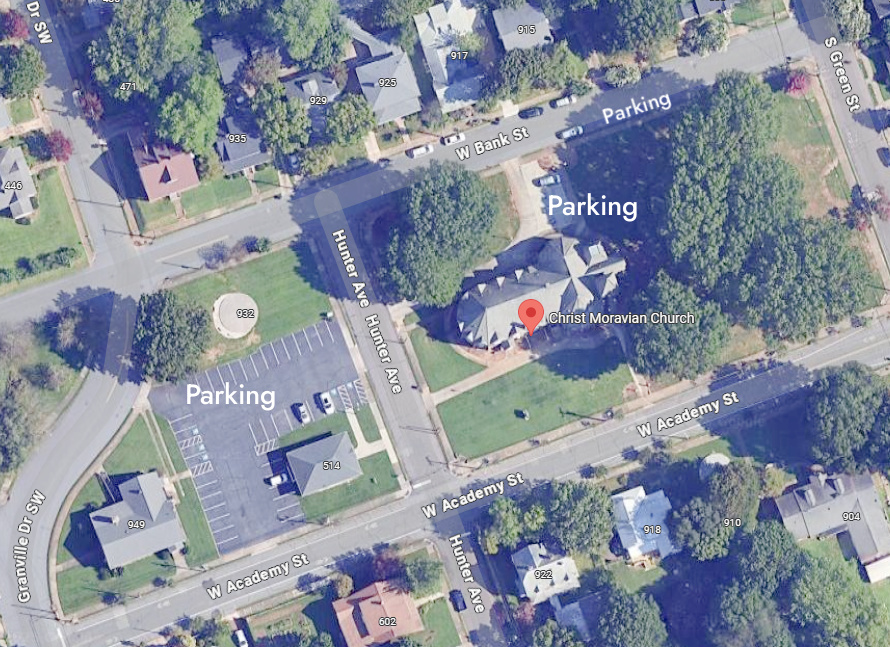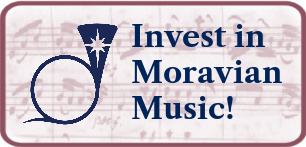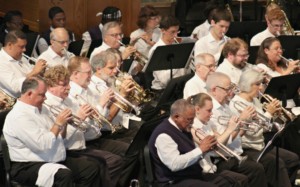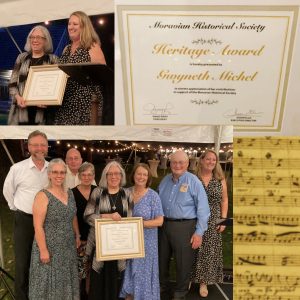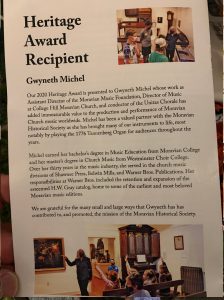TYPES OF RESEARCH PROJECTS & SOME PROJECT IDEAS TO GET YOU STARTED
The following broad categories may spark interest in a variety of possibilities.
Sometimes, research into the holdings of the Moravian Music Foundation culminates with a published anthem or other newly edited musical work. As custodian of a seemingly bottomless well of 18th and early 19th century works for voices and instruments, with words in German and in alte Deutsche Schrift (old German script), as well as instrumental works, the Foundation holds many opportunities. While the study and “resurrection” of this beautiful music is meaningful and welcomed, please be aware of other Moravian musical “treasure troves” waiting to be unlocked and explored.
Terminology
The following definitions are crucial to the understanding of the Moravian Music Foundation’s holdings and of research into “Moravian music.”
Moravian music: works written by Moravian composers, or works written on Moravian themes or tunes.
Holdings of the Moravian Music Foundation: music housed in the vaults of the Moravian Music Foundation in Winston-Salem, NC or in Bethlehem, PA. It is vital to note that the term “holdings of the MMF” is not synonymous with the term ”Moravian music!” Not all Moravian music is housed with the Foundation, nor is all of the music in the Foundation collections “Moravian.” Quick look
In addition, most of this music does not belong to the Moravian Music Foundation but to the congregations of the Moravian Church in America. The Foundation is not the owner, but rather (under contract with these Church entities) the sole custodian and curator of this vast storehouse of musical craftsmanship and artistry. These holdings encompass music both sacred and secular, instrumental and vocal, solo, chamber, and orchestral, of varying periods — and of varying quality and interest.
With these definitions in mind, then, the following are some of the research opportunities available in cooperation with the Moravian Music Foundation. The Moravian Music Foundation welcomes inquiries as well concerning other areas of study. It cannot be overemphasized that what follows is only a starting point, not a complete list of opportunities!
Study and Edition of a Single Work
The end result of this type of project is a scholarly and performing edition of a work housed in the Foundation’s holdings. Included in the study is information about the composer; circumstances surrounding the composition and presentation of the work, if available; and comparison of this work with others by the same composer in MMF holdings. For more information, please review our Editorial Policies. The editor may also write an article discussing the life and work of the composer, other works by the same composer in MMF holdings and elsewhere, and questions of performance practice.
The performing edition may be considered by the MMF for publication; and the accompanying research may be used by the researcher as a term paper, or it may be considered for publication in the Moravian Music Foundation Newsletter.
Reconstruction of an Event
Research of this type, for example, may enable the re-enactment of an historic event or worship service. Study may include the edition of one or more musical selections; the identification of tunes appropriate to hymn texts known to have been used; reference to diaries relating the event; and so on. This is a particularly challenging area of research, but one which can be quite rewarding both during and upon completion of the project. An additional aspect of the project might be the preparation of the actual re-enactment, which would then include issues of historical performance practice.
Composer Studies
This type of research involves the examination of the works of one composer (or perhaps a small group or family of composers) in MMF holdings. The length of the resulting work will depend upon the choice of composer(s) and the depth to which the research is conducted, from the length of an article to that of a doctoral dissertation or book. Some examples follow:
- The first generation of composers (1722-c.1780) of the Renewed Moravian Church (Friedrich, Eberhard, Schlicht, Molther, Grimm)
- The works of J.A.P. Schulz (1747-1800) in Moravian collections
- H.M.H.W. Voullaire (1825-1902), Moravian composer of the Romantic era
- The life and works of Ernst Immanuel Erbe (1854-1927) Now being studied in a doctoral project!
- The life and works of Theodor Liley Clemens (1858-1933)
- Aspects of the music of Charles G. Vardell (1893-1962)
Moreover, compositional technique is an appropriate area of study for a music theory specialist, with topics ranging from cantus firmus writing to the influence of a particular theorist upon the Moravian composers.
Repertoire Studies
The repertoire to be examined may be determined by genre (e.g., sonatas, preludes); by instrument; by date; by physical manifestation (e.g., full score vs. parts, manuscript vs. printed). Studies of this type may relate closely to the investigation of a specific practice as described below:
- Music of the Bach family in Moravian collections
- Early Stephen Foster prints in Moravian collections
- Musical first editions in Moravian collections
- Early prints of non-hymnic Moravian music: What music by Moravian composers (or music on Moravian themes), prior to the latter half of the twentieth century, was published? By whom was it written? For whom was it written? What is the nature of the publication? This study encompasses composers from Latrobe to Erbe, Clemens and Vardell.
- Italian musical prints in Moravian collections.
- Repertoire and resources of the 26th North Carolina Regimental Band
- Early American sheet music in Moravian archives: first editions and rare prints
- Sources of sixteenth-century Moravian congregational song in Bohemia and Moravia (must be able to read Czech and German)
- A reconstruction of the musical repertory of the Graceham, MD, Moravian church (1758-1831)
- History and music of the Salem Orchestra in the nineteenth century
- History and music of the Bethlehem Trombone Choir
- Music for children in Moravian collections (past and present)
- Music for a specific location: for example, the musical life of the Moravians in England; in Labrador; in the Caribbean; in Alaska; in Bethania, NC
Investigation of a Specific Practice
This study involves examination of a body of music in order to answer certain questions: what music actually exists relating to a particular practice or custom? Where does it exist? In what physical condition? Are there markings of any kind on the music? In addition, the study will involve research into descriptive writings in correspondence and diaries.
The Moravian wind band tradition today: Although a number of denominations sponsor church orchestras, the Moravian church retains its two-hundred-year-old tradition of the wind band. Trombone-only choirs exist in several American Moravian churches or communities at the present time; many congregations also have active church bands and instructional programs. As an ongoing link to the history of the Moravian denomination and its continuing commitment to music (instrumental as well as vocal, participation by amateurs as well as by professionals), examination of this practice and its various manifestations promises to be interesting and useful to those participating in or wishing to initiate such ensembles, but our knowledge is far from complete.
Musical life of women in Moravian communities, past and present: This is quite a broad topic, which may be subdivided into a number of articles (which may or may not be the work of a single researcher). The researcher interested in the pre-twentieth-century history (or overseas practices) should be able to read German. Possible subdivisions (or chapter headings) might include Women as Hymn writers; Musical Education of Women; Women as Instrumentalists; Music Written for Women; Music Written by Women; and many other facets.
History of music and music instruction at Moravian educational institutions. Pauline Fox has done a wonderful dissertation on the music at the Moravian schools in Bethlehem, but there’s still room for more research especially for schools in other settlements.
Trends in music editing: The published editions of Moravian anthems (1940-1993) can be seen as a microcosm of the evolution of twentieth-century editorial norms. Over the publication of nearly four hundred anthems spanning some fifty years, editorial practices have undergone a variety of shifts in emphasis. These differences involve such aspects as inclusion of the original language as well as a translation; preferences for old versus modern spellings; indications of editorial emendations or performance suggestions; varying flexibility in adapting orchestral parts to keyboard reductions; varying attitudes towards changing key or adapting notes and rhythms for greater ease in performance, and so on. These differences in interpretation are to be analyzed in light of the contemporary editorial practice. The researcher should have experience in music scholarship and editing, and a familiarity with scholarly editorial practice. The study will involve comparison of some published anthems with the manuscripts, and comparison of several editions of the same work.
Moravian Hymnody: Evolution of tunes and texts over two or three hundred years, including musical settings, text alterations, translations and recastings; knowledge of German important, as is sensitivity to Moravian theology.
Restoration process of the 1800 Tannenberg organ in Salem.
revised: August 2012 by Dr. Nola Reed Knouse, Director
